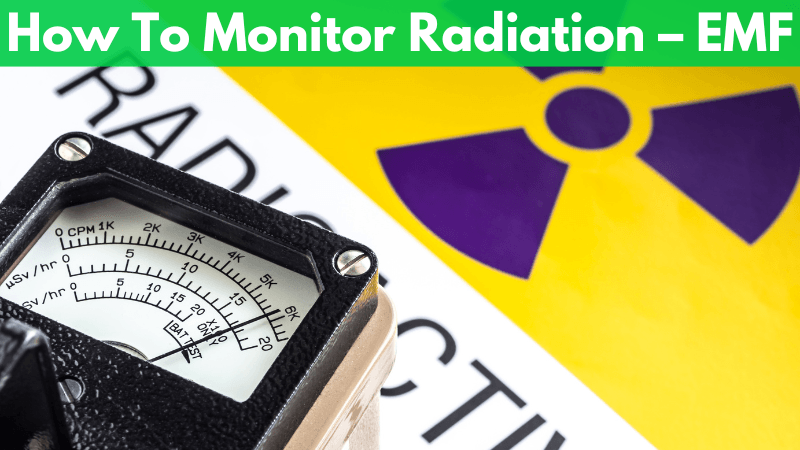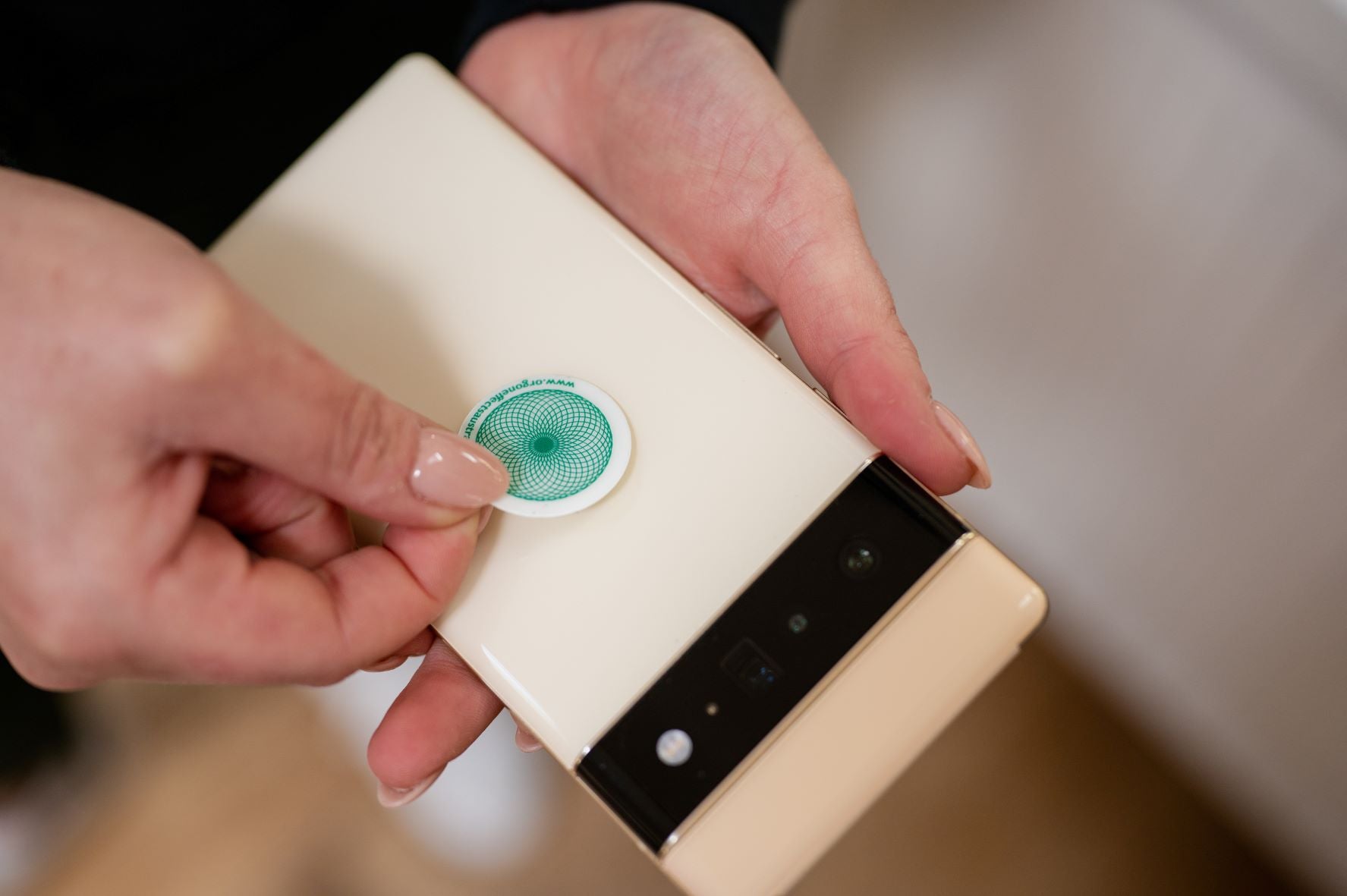Electromagnetic fields are invisible energy forces associated with the use of electrical energy, and everyone has different sensitivities to exposure to electromagnetic fields. It may surprise you that many of our everyday electrical appliances and devices give off EMF.
Generally, EMF danger levels are greatest in the kitchen, but other rooms are also affected depending on your usage of home electronics. To understand the effects of electromagnetic fields, it is important to know what accounts for low and high exposure.
So today we will show you how to understand your EMF readings and how to determine EMF danger levels in the home, office, and your environment at large.
If you want to protect yourself and your family from the harmful effects of EMF radiation, we encourage you to browse through our collection of EMF protection products. We have hand-selected products that we know are high quality and designed to keep you and your loved ones safe.
What Causes High EMF Levels?
Radiation exists throughout what is known as the electromagnetic spectrum. This radiation ranges from very high energy (also known as high-frequency) at one end of the electromagnetic spectrum to very low energy (or low frequency) at the other end.
The following are examples of high-energy radiation:
- gamma rays
- X-rays
- certain higher energy UV (ultraviolet) rays
This high energy is ionizing radiation, which means that this energy can affect cells at the atomic level by eliminating an electron from an atom or “ionizing” it. Typically, ionizing radiation can damage DNA and cells in the body, which can contribute to cancer and genetic mutations.
At the other end of the electromagnetic spectrum is extremely low-frequency radiation (ELF). It is a type of non-ionizing radiation that can move atoms in the body or cause them to vibrate, but most researchers agree it’s not enough to damage cells or DNA.
Between high-energy radiation and ELF radiation in the spectrum are other kinds of non-ionizing radiation, such as:
In most forms of radiation, the electric and magnetic fields combine to form a single field. The result is known as electromagnetic fields (EMFs). But the magnetic and electric fields in extremely low-frequency radiation can act independently. Therefore, we use the terms “electric field” and “magnetic field” to denote these two different fields in extremely low-frequency radiation.
In summary, below are the two types of electromagnetic fields you can be exposed to:
High-Frequency EMF: This is the ionizing form of radiation. The scientific literature agrees that high exposures can damage cells or DNA. Medical equipment, such as X-ray machines and CT scans, produce small amounts of this form of radiation. Other sources include ultraviolet radiation from the sun or tanning beds and gamma radiation from radioactive elements.
Low to Medium Frequency EMF: This is a non-ionizing form of radiation. Home appliances such as microwave ovens, cell phones, hair dryers, and washing machines, as well as power lines and MRIs, all produce this type of radiation. This category of electromagnetic fields includes extremely low-frequency electromagnetic fields (ELF-EMF) and radiofrequency electromagnetic fields (RF-EMF).
Non-ionizing electromagnetic fields come from natural and artificial sources. Earth’s magnetic field is a typical example of a natural EMF. Artificial electromagnetic fields are divided into two types, both produced by non-ionizing radiation:
Extremely Low-Frequency EMF (ELF-EMF) is a non-ionizing radiation field that a wide range of sources can produce, including electrical wiring, power lines, and personal devices such as electric blankets, hair dryers, and electric shavers.
Radiofrequency Radiation is a non-ionizing radiation field emitted by wireless devices such as cell phones, laptops, tablets, and smart meters. Television and radio signals, MRI machines, satellite stations, and radar also produced it.
Surprising EMF Danger Levels in the Average Home

Look around you, do you see anything that threatens your health? At first glance, maybe not. What can your innocent smart TV or old coffee maker do to you?
Well, as you have possibly guessed by now, they can actually have a huge impact over time...and not nicely. It may come as a surprise, but the electronics and appliances you use in your living room, bedroom, bathroom, and kitchen may emit harmful EMFs.
Note that the recommended safe level is 0.5 milligauss and the maximum would be 2.5 milligauss, but 1.0 milligauss or less is better.
Ok, let’s take a look at your living room for instance:
Most homes have cordless phones, computers, vacuum cleaners, and televisions that they use daily or weekly in the living room. Sadly, these appliances and devices can turn your living room into a dangerous zone.
What about your bathroom and bedroom?
You might have a fluorescent light fixture by your bed and a hair dryer by your sink. Of course, a washing machine should not be missing, even if it can be located elsewhere.
But look at this:
As it’s obvious, we have to be vigilant about radiation levels in our homes because high EMF readings are found where you least expect them.
EMF Danger Levels

EMF danger levels are monitored and enforced globally, nationally, and locally in a diverse patchwork of procedures by multiple organizations depending on where you reside. The UK electrical industry maintains a database where you can view exposure limits and enforcement measures for a variety of countries around the world.
Internationally, the most important guidelines on radiofrequency electromagnetic fields come from the International Commission on Non-Ionizing Radiation Protection (ICNIRP). Its guidelines are based on his long-standing review of the peer-reviewed scientific literature on the health effects of RF electromagnetic field exposure. This non-governmental organization is recognized by the WHO (World Health Organization).
In 2020, the WHO updated its international ICNIRP guidelines to limit exposure to higher levels of RF electromagnetic fields in the range of 100 kilohertz to 300 gigahertz. ICNIRP guidelines currently state that people at work should not be exposed to the neck, head, and torso electrical current densities greater than 10 mA m-2.
A lower limit of 2 mA m-2 is provided for the general population to account for infants and possibly more sensitive individuals. The expression 10 mA m-2 represents a measure of electric current density. Translated, this means “10 milliamps per square meter.” A milliamp is 1/1000 amp. This is the level above which magnetic and electric fields have been shown to affect body tissues and cognitive functions of the brain.
The United States does not have federal limits on total EMF exposure, but some states have enacted their own limits. In addition, various federal agencies are responsible for managing EMF exposure to specific technologies and products.
The EPA (Environmental Protection Agency) coordinates EMF exposure guidelines in the United States. It is usually based on the ICNIRP guidelines. In its guidelines on EMF, the EPA notes that ICNIRP’s EMF exposure limits protect people from “known health and biological effects of exposure to high levels of EMF.”
However, the EPA takes a different stance on low levels of electromagnetic radiation. The EPA noted in its EMF Guidelines that it does not recommend or impose limits on low-level electromagnetic fields because there is no scientific evidence that low-level EMF radiation is harmful to human health.
To back up its claim about the relative safety of low-level electromagnetic radiation, the EPA released its Official 2020 Report, a literature review of about 70 extensive studies conducted between 2008 and 2018. The report mainly focused on cancer, but also addressed many other health issues.
In the US, different government agencies have specific responsibilities for managing exposure to electromagnetic fields from different products, facilities, and technologies. Local governments often impose their own regulations and controls. Below are typical examples of federal controls:
- Electronic appliances. Standards for all electronic appliances that emit ionizing or non-ionizing radiation are set by the United States Food and Drug Administration (FDA).
- Mobile phones. The FCC (Federal Communications Commission) sets limits for electromagnetic emissions from cell phone towers and cell phones. The FCC’s guidelines and rules are based on standards designed by the Institute of Electrical and Electronics Engineers (IEEE) and the National Council on Radiation Protection and Measurements (NCRP), as well as input from other government agencies.
- Smart meters. The FCC sets exposure limits for radiation given off by smart meters, those boxes on the sides of homes and businesses that use a cellular transmitter to track energy use.
- Power lines. There are currently no federal restrictions on electromagnetic fields from power lines in residential or work environments.
- Medicinal use. Many medical procedures and devices use ionizing radiation to diagnose and treat diseases and conditions. Some examples are radiation therapy, CT scans, and X-rays. Several regulatory agencies share responsibility for the safety of these devices and procedures, including the Centers for Disease Control and Prevention (CDC), EPA, FDA, and the US Nuclear Regulatory Commission (NRC).
- Nuclear energy. Several regulatory agencies share responsibility for regulating nuclear energy and coordinating disaster relief, including the EPA, the NRC, and the Federal Emergency Management Agency (FEMA).
- Imported products. U.S. Customs and Border Protection (CBP) inspects imported products to ensure they are free of harmful substances.
- Workplace. EMF exposure in the workplace is regulated by law and enforced by the Health and Safety Authority (HSA).
What Does EMF Exposure Do to Your Body?
There is disagreement in the scientific literature as to whether electromagnetic fields pose a risk to human health and, if so, to what extent. The International Agency for Research on Cancer (IARC) has classified non-ionizing radiofrequency electromagnetic fields as Group 2B, a possible human carcinogen. These fields are generated by electronic products such as cell phones, tablets, and smart devices.
IARC works under the aegis of the World Health Organization (WHO). It regularly brings together working groups of scientists from around the world to assess the risks of cancer in humans because of lifestyle and environmental factors.
The current IARC assessment from 2011 showed a potential link between human cancer and RF radiation, specifically glioma, a malignant form of brain cancer. This conclusion means that there could be some risk. The report stresses that the scientific community must carefully monitor the link between cell phone use and cancer risk. It said more research was needed on long-term heavy cell phone use.
Some researchers believe there is already enough evidence of damage from low-level and long-term exposure to non-ionizing radiation for the IARC to update the classification to Group 1, a known carcinogen. Researchers began extensive research into the potential link between cancer and cell phones in 2000 in the largest study comparing cancer cases among cell phone users and non-users.
The researchers tracked cancer rates and cell phone use among over 5,000 individuals in 13 countries. They found a loose association between glioma and higher exposure rates. The gliomas were most often found on the same side of the head that people used to make phone calls.
Still, the researchers said the link was not strong enough to conclude that cell phone usage causes cancer. In a smaller, more recent study, researchers analyzed nearly two decades of data and found that people exposed to high levels of extremely low-frequency electromagnetic fields (ELF-EMF) for prolonged periods were at increased risk of acute myeloid leukemia (AML), a kind of leukemia in adults.
European scientists have also discovered a potential link between electromagnetic fields and childhood leukemia. In a literature review of previous studies, they suggested that 1.5-5% of leukemia in children can be attributed to ELF-EMF. However, they noted that the result was inconclusive due to a lack of EMF monitoring. They recommended better monitoring and more research.
A review of over two dozen studies on low-frequency electromagnetic fields suggests that these energy fields can cause various psychiatric and neurological problems in humans. In one study, researchers found that an electromagnetic pulse (EMP), or a brief burst of electromagnetic energy, can affect nerve activity in rats. They suggested that long-term exposure to EMPs could impair cognitive abilities and produce pathology similar to that of Alzheimer’s disease. They added that more research is required.
Additionally, preliminary research suggests that body tissue and the nervous system may be affected by the heat generated by radio frequency EMF. A study in mice and rats suggested that the heat from cell phones affects the heating of body tissues and nerve activity. Again, the researchers said more study is needed. Another research report suggested that radiofrequency electromagnetic fields may contribute to neurological, and cognitive impairment.
Possible EMF-related symptoms in the studies included:
- dizziness
- headache
- memory loss
- tremor
- sleep disturbance
- loss of focus
Protection from EMF Danger Levels
You don’t have to live without your microwave or favorite appliance, but it is extremely important to think about how you use it to limit yourself and your loved one’s exposure to EMF. Protect yourself by researching how to reduce EMF danger levels in your home and following the tips below.
Invest in Wearable Protection
Those who want round-the-clock protection should opt for orgone jewelry. Wearing an orgone pendant or necklace means they are close to your skin, which is even more beneficial. As you already know, you can have deadly orgone energy in your body, so this jewelry can cleanse your body of this negative energy and replace it with positive energy. Orgone home devices and jewelry can protect your mental and physical health.
Use EMF Harmonizers
Orgone energy is all around us and must be harnessed in a way that allows it to move freely and not become stagnant. Just as orgone energy surrounds us, negative energy emitted by all the devices we have in our homes also surrounds us. Televisions, laptops, refrigerators, cell phones, Wi-Fi routers, and washing machines can cause symptoms such as anxiety, depression, headaches, and lower energy levels.
Having a GeoClense EMF and Earth Radiation Harmonizer in your home allows you to shield yourself from the negative energy emitted by these devices and turn it into something positive. In addition, they also clean the electromagnetic fields that are causing these symptoms.
Purchase Phone & Computer EMF Protectors
The Phone Computer Bluetooth Wi-Fi Radiation Protection can be attached to the back of cell phones (or cases), Bluetooth, computers, iPads, baby monitors, and other wireless devices. This product is more effective than any other product which acts as a “shield” as they harmonize and neutralize the harmful effect, rather than attempting to block it - which only leads to generating more radiation.
Invest in Orgone EMF Blankets
If a family member suffers from night terrors, they can wrap themselves in protection with our Bamboo Orgone Blankets. These environmentally friendly Bamboo Orgone Blankets are infused with octaves of frequencies that create and bring into being a powerful Negative Ion resonance used for energy healing or EMF protection, making them the best in natural sleep aids.
Final Thoughts on EMF Danger Levels
Electromagnetic fields occur naturally and also come from man-made sources. Generally, scientists and regulators agree electromagnetic fields pose a low risk to human health. However, some researchers offer preliminary evidence that there may be some danger with long-term use, particularly for the nervous system and cognitive function of the brain.
Exposure to high levels of radiofrequency electromagnetic fields is known to damage human cells and DNA. Therefore, it is highly likely that you will be exposed to levels in your daily life that are high enough to be dangerous to your health.
The best approach is to be aware of the existence of electromagnetic fields and to be cautious about your exposure. This is an evolving area of research that will no doubt expand as our use of labor-saving machines and wireless devices increases. Purchase EMF protection products today to protect yourself from EMF danger levels.



